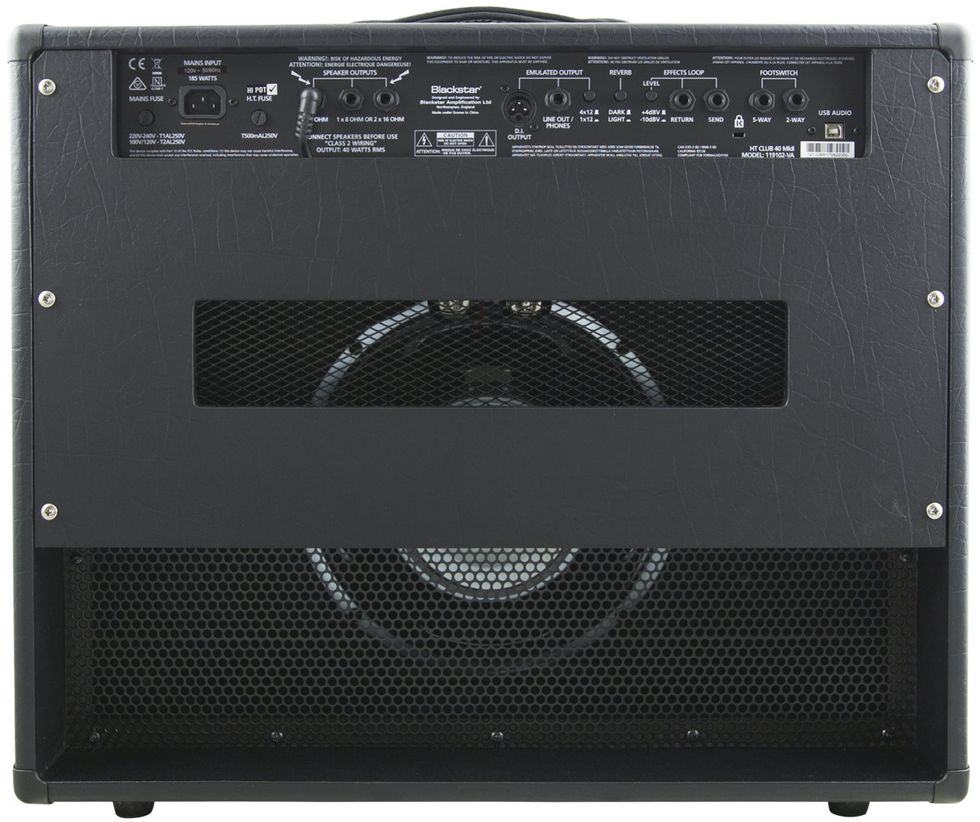The new Mark II version of Blackstar’s HT Club 40 looks backward and forward in time. Its tones evoke the great 50-watt Marshall amps of the ’60s and ’70s, thanks in part to a pair of EL34 power tubes. Meanwhile, it’s packed with modern features that expand the amp’s tonal range and facilitate recording. The China-built 1x12 combo sells for a budget-friendly $699.
Full of Flavors
The HT Club 40 has two independent channels for clean and gain tones. Each channel has a push button that dramatically alters its voice. On the clean side, one voice remains tight and clean even at high volume, while the other generates bright, ultra-present distortion with the level cranked.
On the dirty side, you can toggle between a classic Marshall-style profile and a higher-gain setting with the greater compression and midrange bulk of a post-’80s amp with multiple gain stages. You can switch channels and voicings via footswitch. (Blackstar says the switch is included, but we didn’t receive one for testing.)
EQs You Can Use
The clean channel employs a simple pair of bass and treble controls. The overdrive tone stack is trickier: Its treble, mid, and bass controls are paired with an ISF (“infinite shape feature”) knob. This fades between two contrasting EQ profiles. Again, one profile recalls a vintage Marshall, while the other sounds more modern, with aggressive mids and djent-intensive lows. Even better, you can fade between the two characters, accessing cool hybrid tones. Between the ISF pot and the voicing switch, there are a lot of distortion flavors here.
You can hear some of the possibilities in the demo clip, along with a couple of clean sounds. Note that I recorded the entire clip using just one pickup on one guitar. (It’s the bridge pickup on a solidbody parts guitar with retro-style PAFs.) I don’t switch pickups or alter the guitar’s tone settings—all the tonal variation comes from the amp. Nor did I lower the guitar volume knob from its maximum position. But since the Club 40 is quite dynamically responsive, I could have created even more variations by attenuating the amp input. It’s an extraordinarily versatile control set.

This amp puts out a loud 40 watts, with excellent dispersion thanks to the open-backed cabinet. Fortunately, there’s a switch that cuts the power down to 4 watts, and you’re likely to use it. (Remember, that’s about half volume, not 10 percent volume, according to the way our ears perceive loudness.)
All About the Crunch
Note that most of the tone-sculpting action takes place in the overdrive channel. The clean tones are perfectly nice, and you can get powerful crunch sounds on the clean side, especially with the voice switch in the out position. Still, the Club 40 is most likely to appeal to players who tend to hang out on the distortion side of the spectrum.
Ratings
Pros:Excellent and varied crunch tones. Recording-friendly features. Solid construction.
Cons:
Minor quality-control issues.
Tones:
Ease of Use:
Build/Design:
Value:
Street:
$699
Blackstar HT Club 40 MkII
blackstaramps.com
The single 12" Celestion Seventy 80 speaker keeps those high-gain tones crisp and articulate. It has an upper-midrange spike that emphasizes pick attack, and some sub-100 Hz roll-off that, ironically, keeps the low end heavy and tight. Though the Club 40 can generate huge amounts of gain, tones remain punchy and well defined. And they’re likely to remain decisive even after you plug in a fuzz or distortion pedal.
The Club 40’s onboard digital reverb provides a solid reverb tank simulation, though, as on most faux springs, it’s a static effect that doesn’t respond dynamically to varying input levels. One nice touch: a rear-panel switch to toggle between bright and dark reverb algorithms.
Tailored for Tracking
Many of the amp’s new-for-Mark II features appear on the rear panel. In addition to three speaker output jacks, there are both XLR and 1/4" direct recording outputs—the latter doubling as a headphone jack. Both include emulations of 1x12 and 4x12 cabinets, selectable by a rear-panel switch. The simulation is definitely good enough for headphone practicing and possibly for tracking. There’s even a USB output jack for connecting the amp directly to your computer or audio interface. Finally, there’s a mono effects loop switchable between mic and line levels.
The amp’s construction is solid for its price range. The electronic components—including the pots and jacks—are arranged on circuit board. The transformers are from Taiwan’s Chuang Meei company. The composite cabinet feels sturdy. There were, however, a couple of minor quality-control issues: Several pots sounded scratchy, though an application of electronic contact cleaner would probably heal them. Also, one of the preamp tubes was intermittently noisy.
The Verdict
Blackstar’s HT Club 40 MkII provides nice, solid clean tones. But its star feature is a vast array of massive yet punchy distortion sounds, thanks to a multi-voiced gain channel and an innovative tone stack. The amp is plenty loud for gigs with an aggressive drummer, while multiple recording outs make it equally suited for the studio. It’s solidly made for a production-line circuit board amp. Fine crunch sounds and ingenious design details make the Club 40 a bargain in its price range.








![Rig Rundown: Russian Circles’ Mike Sullivan [2025]](https://www.premierguitar.com/media-library/youtube.jpg?id=62303631&width=1245&height=700&quality=70&coordinates=0%2C0%2C0%2C0)

















